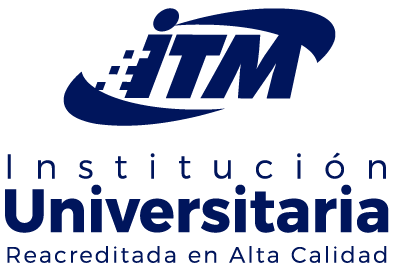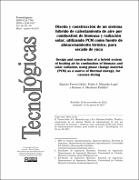Mostrar el registro sencillo del ítem
Diseño y construcción de un sistema híbrido de calentamiento de aire por combustión de biomasa y radiación solar, utilizando PCM como fuente de almacenamiento térmico, para secado de yuca
| dc.contributor.author | Torres-Gallo, Ramiro | |
| dc.contributor.author | Miranda-Lugo, Pedro J. | |
| dc.contributor.author | Martínez-Padilla, Keimer A. | |
| dc.date.accessioned | 2019-07-18T14:13:12Z | |
| dc.date.accessioned | 2019-08-22T13:53:37Z | |
| dc.date.available | 2019-07-18T14:13:12Z | |
| dc.date.available | 2019-08-22T13:53:37Z | |
| dc.date.issued | 2017-05-02 | |
| dc.identifier | https://revistas.itm.edu.co/index.php/tecnologicas/article/view/693 | |
| dc.identifier | 10.22430/22565337.693 | |
| dc.identifier.uri | http://hdl.handle.net/20.500.12622/1011 | |
| dc.description.abstract | Este estudio consistió en el diseño, la construcción y la validación de un sistema híbrido de calentamiento de aire por combustión de biomasa y radiación solar, utilizando material de cambio de fase (PCM) como fuente de almacenamiento térmico, para el secado de yuca, a pequeña escala. El sistema híbrido consta de un ventilador centrífugo, dos colectores solares, un quemador de combustible sólido (cascarilla de arroz) y un secador de bandejas. La validación del sistema se realizó secando yuca. El PCM permitió seguir el proceso de secado, incluso cuando la radiación solar estuvo por debajo de 116,22 ± 31,94 W/m2, logrando mantener temperaturas de aire de secado en los dos colectores solares a 46 ±4 ,29°C y 51± 4,08°C durante 45 min adicionales. El tiempo de secado fue de 10 h y 45 min, la eficiencia de los colectores solares fue 43,91% y la del quemador de cascarilla de arroz de 36,72%. | spa |
| dc.format.mimetype | application/pdf | |
| dc.language.iso | spa | |
| dc.publisher | Instituto Tecnológico Metropolitano (ITM) | spa |
| dc.relation | https://revistas.itm.edu.co/index.php/tecnologicas/article/view/693/675 | |
| dc.rights | https://creativecommons.org/licenses/by/3.0/deed.es_ES | spa |
| dc.source | 2256-5337 | |
| dc.source | 0123-7799 | |
| dc.source | TecnoLógicas; Vol 20 No 39 (2017); 69-81 | eng |
| dc.source | TecnoLógicas; Vol. 20 Núm. 39 (2017); 69-81 | spa |
| dc.subject | Secado | spa |
| dc.subject | yuca | spa |
| dc.subject | PCM | spa |
| dc.subject | tiempo de secado | spa |
| dc.subject | híbrido | spa |
| dc.subject | calentamiento | spa |
| dc.title | Diseño y construcción de un sistema híbrido de calentamiento de aire por combustión de biomasa y radiación solar, utilizando PCM como fuente de almacenamiento térmico, para secado de yuca | spa |
| dc.title.alternative | Design and construction of a hybrid system of heating air by combustion of biomass and solar radiation, using phase change material (PCM) as a source of thermal storage, for cassava drying | |
| dc.subject.keywords | Drying | eng |
| dc.subject.keywords | cassava | eng |
| dc.subject.keywords | PCM | eng |
| dc.subject.keywords | hybrid | eng |
| dc.subject.keywords | heating | eng |
| dc.type | info:eu-repo/semantics/article | |
| dc.type | info:eu-repo/semantics/publishedVersion | |
| dc.type | Research Papers | eng |
| dc.type | Artículos de investigación | spa |
| dc.relation.ispartofjournal | TecnoLógicas | |
| dc.description.abstractenglish | This study consisted of designing, building and validation a hybrid system of heating air by combustion of biomass and solar radiation, using phase change material (PCM) as a thermal storage source, for cassava drying, a small scale. The dryer consists of a centrifugal fan, two solar collectors, a fuel burner solid (rice husk) and a tray dryer. System validation was performed drying up Yucca. The PCM allowed to follow the drying process, even when the solar radiation was below 116,22 ± 31,94 W / m2, being able to maintain drying air temperatures in the two solar collectors at 46 ± 4, 29 ° C and 51 ± 4.08 ° C for an additional 45 min. The drying time was 10 h and 45 min, the efficiency of the solar collectors was 43.91 % and the rice husk burner of 36.72 %. | eng |
| dc.rights.accessrights | info:eu-repo/semantics/openAccess | |
| dc.type.coar | http://purl.org/coar/resource_type/c_6501 |


